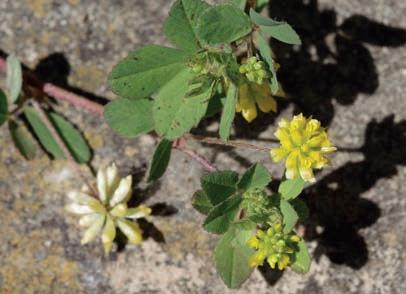
4 minute read
Beginner's Corner: Yellow-flowered trefoils and medicks
Yellow-flowered trefoils and medicks – a guide to our commoner native species
JOHN NORTON
Advertisement
These five yellow-flowered native legumes all resemble clovers in their trifoliate leaves and creeping habit. All usually grow as annuals, especially in short turf and disturbed habitats. Although familiar to all botanists, they are a common source of confusion to beginners and even the more experienced. Here is a short guide to the main ID features and typical habitats. Photographs by the author.
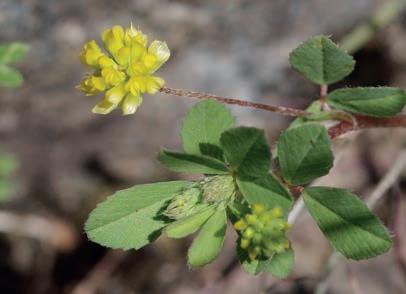
Lesser Trefoil (Trifolium dubium). The commonest of the three trefoils and found throughout the whole of Britain and Ireland. Flowerheads are round (globose), less than 1 cm across, on a long stalk, usually with about 15–20 individual bright yellow flowers (each 3–4 mm long), but beware poorly developed heads with only a few flowers, which make it confusable with Least Trefoil. Leaves are glabrous (hairless) above or may have a few hairs around the margins or underneath. The middle leaflet does not have a green tooth at the apex like Black Medick, but there may be a tiny bristle. Occurs in various types of neutral to mildly acidic short grassland, which can be dry, or winter-wet; and in disturbed habitats and sometimes urban environments.
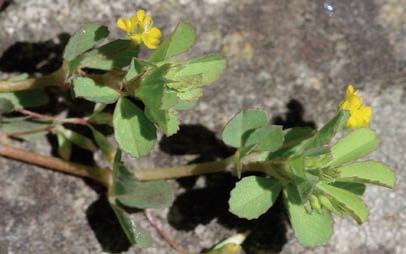
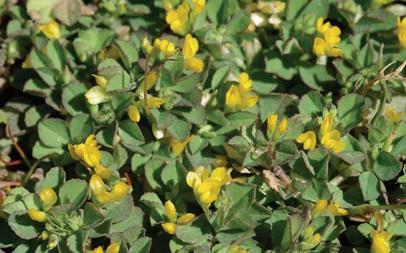
Least Trefoil (Trifolium micranthum). Similar to Lesser Trefoil but has only a few (2–6) deeper yellow flowers, which are distinctly smaller (1.5–3 mm long), in clustered (not globose) heads. As the name implies a truly diminutive species which rarely grows more than a couple of centimetres tall. Favours well grazed pony fields and dry acid grassland. Common in lowland areas but mainly a coastal plant in Scotland and Ireland.
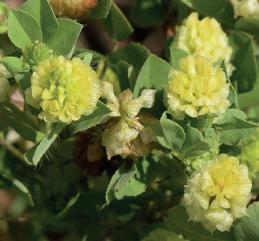
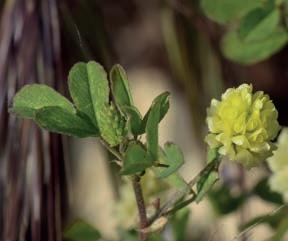
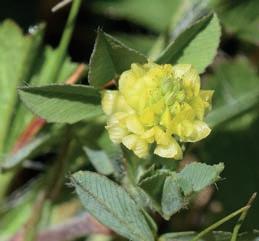
Hop Trefoil (Trifolium campestre). The largest of the trefoils, growing up to 30 cm high. Distinctive in having large, pale yellow ‘pom-pom’-like flowerheads, each with more than 20 individual flowers, 4–7 mm long. Close up it can be seen that the petals are broader than the other two species and have a corrugated texture which gives the whole flower a resemblance to the fruits of Hop (Humulus lupulus). Leaves are sparsely hairy, as in the other two species. Favours disturbed, well drained and sunny calcareous habitats, but also occurs in dry acid grassland where there is some gravel or shingle present.
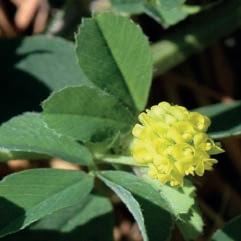
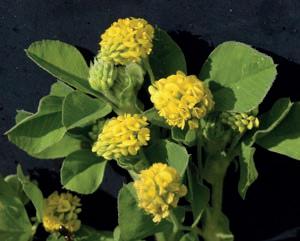
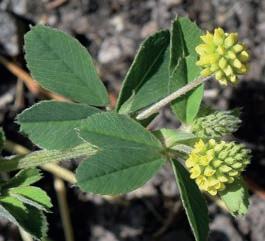
Black Medick (Medicago lupulina). Medicks are distinguished from the trefoils by the small triangular green tooth at the apex of the middle leaflet. Black Medick leaflets are usually silvery hairy above and have a broader shape than those of the trefoils. The flowerheads are closest in appearance to Lesser Trefoil, but a bit larger and denser, with more flowers, which are usually a slightly paler yellow. The fruiting heads (not shown) are characteristic, turning black when ripe. Widespread and common throughout the British Isles, favouring dry neutral to calcareous grassland and disturbed habitats. Often trailing but can grow to 50 cm or more.
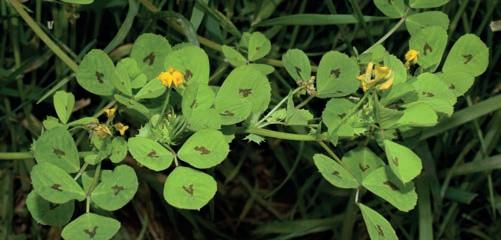
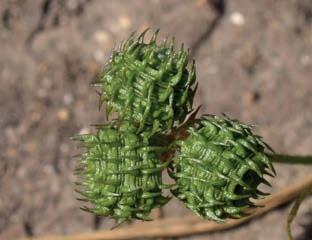
Spotted Medick (Medicago arabica). Easily identified by the characteristic purple chevron marks on its glabrous leaflets, though sometimes these are very faint. Flowers are deep yellow, in clusters of 2–6, c. 3-6 mm long. Also note the sharply toothed stipules and the distinctive spiny fruits. It is the least widespread of the five, common only in southern England, where it occurs in similar habitats to Lesser Trefoil. The similar Toothed Medick (M. polymorpha) is a rarer species without spotted leaflets, and is more strongly coastal.










